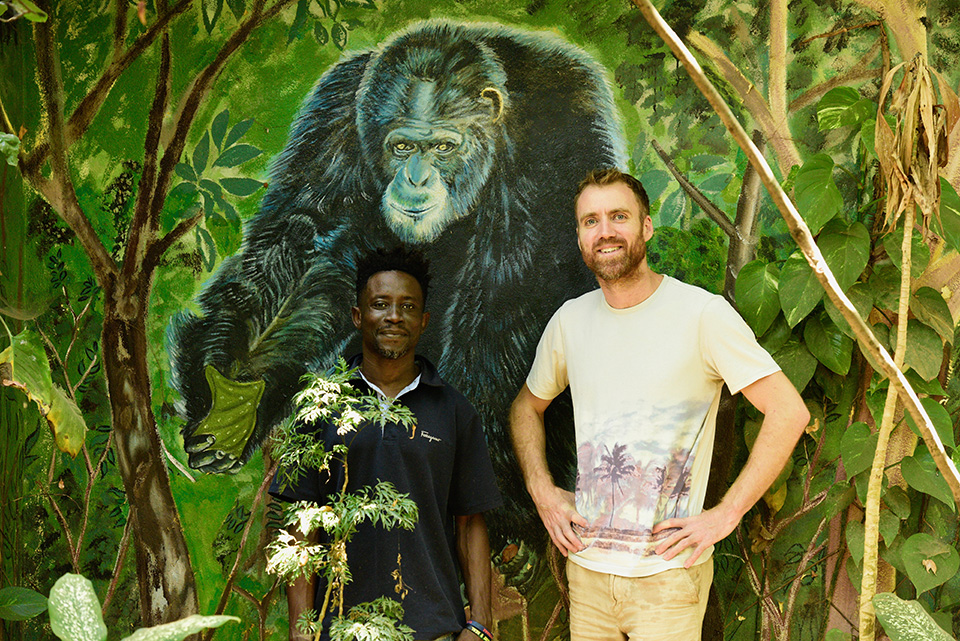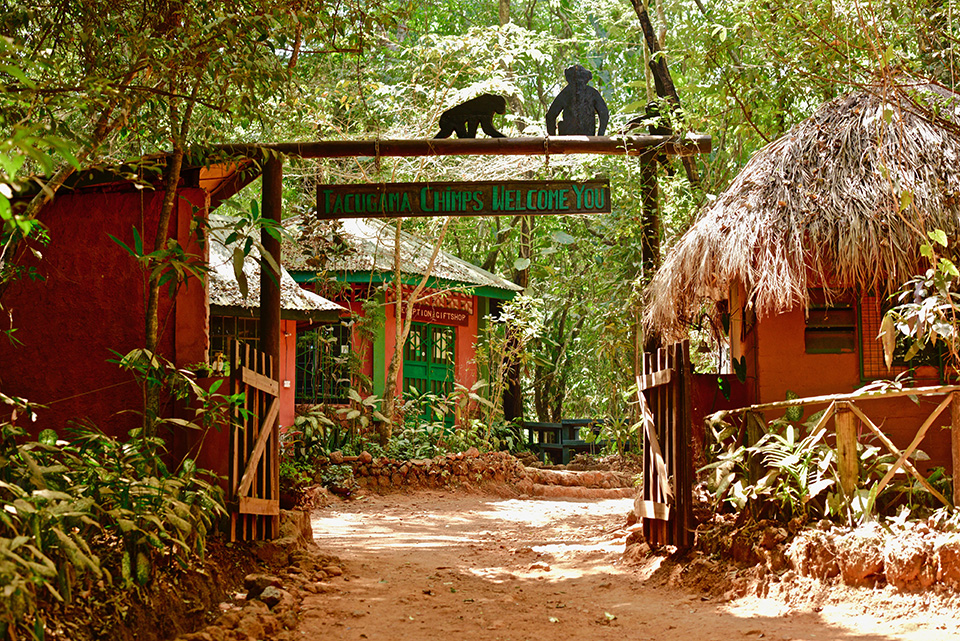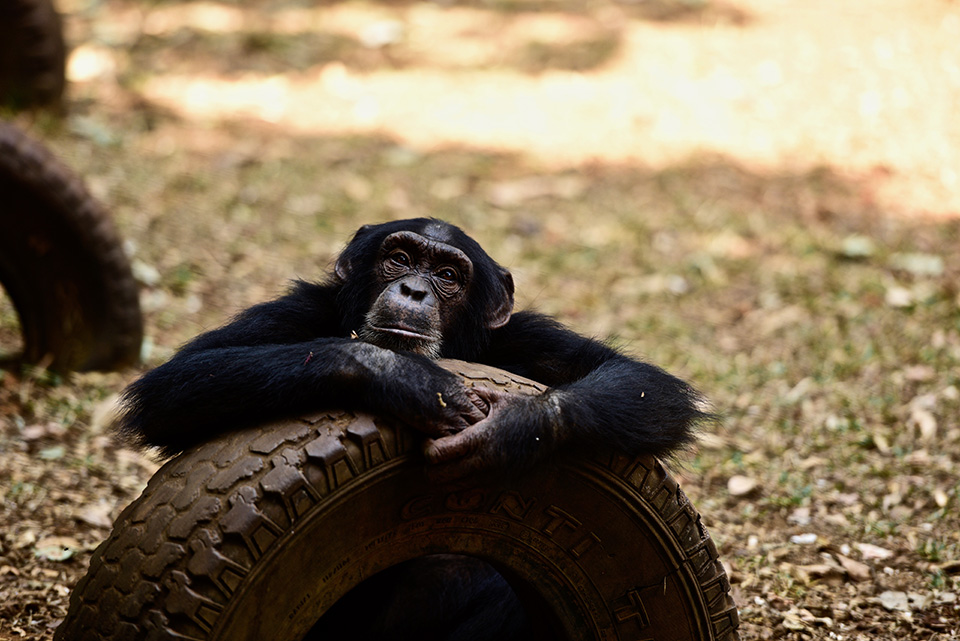Visit of Dr. Jane Goodall to Sierra Leone
News
27 February 2019
Franklyn Badeye Sesay of Tacugama with Irish author Paul Glynn in front of a mural of "King" Bruno
On 27 February, Sierra Leone welcomed the world's foremost expert on chimpanzees, Dr. Jane Goodall (DBE, anthropologist and UN Messenger of Peace), to Freetown, where 27 years ago she was instrumental in the founding of the Tacugama Chimpanzee Sanctuary.
Tacugama Chimpanzee Sanctuary
Tacugama, Sierra Leone's first and only sanctuary, plays a crucial role in protecting the country's rich biodiversity and critically endangered chimpanzees. Since its establishment, the sanctuary has become internationally recognized, benefiting Sierra Leone's people through jobs, wildlife protection, environmental education, ecotourism, and research and health initiatives.

Dublin Zoo and Tacugama Chimpanzee Sanctuary
Today, Sierra Leone is home to one of the world's largest western chimpanzee populations. We know this thanks to the support of partners including Dublin Zoo for Tacugama Chimpanzee Sanctuary to conduct a census of western chimpanzees in 2009. The census estimated that at the time there were 5,500 western chimpanzees living in Sierra Leone, with half this number living outside of protected areas. The census has helped to develop conservation activities to help protect chimpanzees living in Sierra Leone.
Dublin Zoo – home to Betty and Wendy
Dublin Zoo's connections with Sierra Leone chimpanzees go all the way back to 1964, when 2-year old chimpanzees, Betty and Wendy arrived at Dublin Zoo from Sierra Leone. Betty is still alive today, one of the oldest and most-loved chimpanzees at the Zoo.
When Dublin Zoo first began breeding chimpanzees in 1974, Betty and Wendy were the first females to breed, and now many of their offspring live across Europe as part of the European breeding programme for chimpanzees, which aims to contribute to their survival.

Responding to crisis
The Ebola crisis claimed the lives of almost 4,000 people in Sierra Leone. The outbreak also had a big impact on Tacugama. Approximately 50% of its income came from tourism and fieldwork and these activities completely ceased during the outbreak. Dublin Zoo provided funding to Tacugama to help ensure the continued high level of care of the chimpanzees in the sanctuary. This funding also helped Tacugama to maintain staff during a time of serious humanitarian crisis, which caused additional hardships for the people of Sierra Leone, already one of the world's poorest countries. In August 2017, Dublin Zoo provided an additional donation to Tacugama Chimpanzee Sanctuary to assist them with relief work after devastating flooding and mudslides in Freetown impacted many of the families that the Tacugama Chimpanzee Sanctuary work with in their outreach projects.
Community outreach for conservation and better livelihoods
Since 2015, Dublin Zoo has provided funding for the Tacugama Community Outreach Programme (TCOP) to promote community conservation. A major loss of chimpanzee habitat in Sierra Leone is due to slash-and-burn agriculture, whereby the vegetation is cut down and burnt, and creating land for farming. However, the soil on this land is poor and farmers need to slash and burn more forest after a few years. TCOP is working with farmers to use permanent fields and build up soil health, thus reducing the need to destroy chimpanzee habitats. TCOP is also encouraging farmers to return some farmland to the forest. In addition, TCOP is arranging workshops with local communities, including school children, to talk about chimpanzees, habitat protection, conservation and how it affects their local community.
Since 2018, TCOP's alternative livelihoods and conservation work with local communities is also being supported by the Embassy of Ireland in Sierra Leone.
Irish creative Paul Glynn & the story of King Bruno's Great Escape
In 2006, Bruno, an alpha male chimpanzee, led an escape of 30 of Tacugama's chimpanzees from the sanctuary. Orphaned by hunters, Bruno had spent his life among humans, surviving Sierra Leone's civil war, before being rescued by Sri Lankan couple Bala and Sharmila Amarasekaran and becoming the inspiration for them to establish Tacugama Sanctuary on 100 acres of national park forest outside Freetown. At the time, chimpanzees were regularly killed for their meat with their babies being sold as pets, leading to dramatic reductions in the number of chimpanzees inhabiting Sierra Leone. The chimpanzees' escape was devastating for sanctuary staff but within two weeks, 21 chimpanzees had returned, 19 having done so of their own will. Within two months, 26 of the 31 chimpanzees were back at the sanctuary, though Bruno remains at large to this day, a local legend.
Author, illustrator and documentary maker, Paul Glynn, originally from Dublin, has turned Bruno's story into an illustrated children's book. "King Bruno" tells Bruno and Bala's story with the aim of educating young people about chimpanzees, conservation and development and a proportion of proceeds being used to support Tacugama.
Read an interview with Paul Glynn about his work.
RTÉ tells Tacugama's story
In 2016, Paul brought Tacugama's story to the attention of producer Michele Brown at RTÉ's Documentary on One. With support from the Irish Aid programme at the Department of Foreign Affairs and Trade, the Documentary on One travelled to Sierra Leone to produce the story of Bruno the Chimpanzee, which you can download or listen to.
Dr. Goodall's visit to Freetown
Dr. Goodall's three day visit in February 2019 highlights the emerging conservation movement in Sierra Leone as well as the country's re-emergence on the world stage as a sustainable tourism destination.


